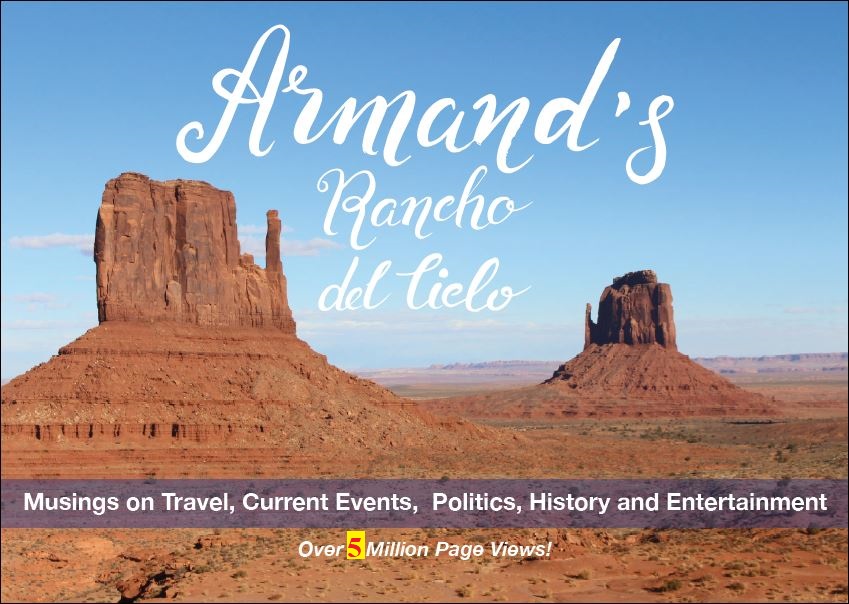 |
| Above, yours truly at the Plaza de la Revolución. Photo by Mitch Geriminsky. |
Last Thursday, the big highlight of our cruise aboard Royal Caribbean's
Majesty of the Seas took place when we arrived in Havana Harbor in Cuba.
 |
| Above, approaching Havana from Florida. Photo by Armand Vaquer. |
When I was first approached about taking the trip (the price was great and never a factor) by Mitch Geriminsky, I hadn't given any thought to taking a cruise. I went on a cruise in 2000 with my mom and daughter to Alaska. Seeing Alaska was nice, but I found that being on a ship to be on the tedious side, especially since it was cold outside despite it being a summer month.
 |
| Above, the terminal where we were processed into Cuba in the foreground. Photo by Armand Vaquer. |
Still, I was intrigued about a cruise to Cuba. Anyone can go to Alaska, Spain or anywhere else at anytime. But Cuba? I figured, "Why the hell not? I'm retired!" So I agreed to make the trip. (This may be one of the last cruises to Cuba according to recent news reports.)
 |
| Above, an old "rust bucket" of a ship in Havana Port. Photo by Armand Vaquer. |
We arrived in Havana Harbor (formally known as Havana Port) at about dawn. The harbor wasn't too busy. I noticed a ship not too far away that can be accurately described as a "rust bucket". The terminal buildings were either gutted of any exteriors or rundown.
 |
| Above, yours truly with Mitch Geriminsky in the terminal building. |
Before we could disembark the ship, Cuban authorities had to provide clearances. So we had plenty of time to have breakfast up in the Windjammer restaurant on the 11th deck.
 |
| Above, Havana's Sloppy Joe's Bar. Photo by Armand Vaquer. |
When it was getting closer for us to be able to disembark, we had to go to one of the main dining rooms to be organized into tour groups. Ours was #22. We signed up for Royal Caribbean's "Old Havana City Sightseeing". This was essentially a bus tour of Havana with stops at the
Plaza de la Revolución, Fortaleza de San Carlos de la Cabaña, Colon Cemetery and shopping.
 |
| Above and below, some 1950s vintage American cars. Photos by Armand Vaquer. |
Once we left the ship and entered the terminal, we were surprised to see the interior in far better shape than the exterior. We were able to exchange dollars for Cuban Convertible Pesos (CUC) (this is the currency for foreigners). I figured $130 in Cuban Convertible Pesos should be sufficient to buy cigars and rum, so that's what I exchanged.
 |
| Above, the El Capitolio. Photo by Armand Vaquer. |
Immediately after our bus left the terminal, we saw the famous 1950s American automobiles that the Cubans still drive. They have employed a number of inventive ways to keep them running, including installing Russian engines in them.
We passed Havana's Sloppy Joe's Bar. We also saw one in Key West the day before.
 |
| Above, a bust of Abraham Lincoln in a Havana park. Photo by Armand Vaquer. |
The driver took us around Havana. In one park in the city, there is a bust of President Abraham Lincoln. I guess Lincoln is still revered in Cuba. We also passed the El Capitolio, or the National Capitol Building. It is modeled after the U.S. Capitol and currently undergoing renovation.
 |
| Above and below, apartment buildings. Photos by Armand Vaquer |
One thing that stood out for me were how drab the buildings in the city are. They looked as though they hadn't been cleaned or painted for a long time. This includes private homes and apartments. Our guide said this has been the case since the fall of the Soviet Union in 1989, thereby cutting off the money spigot. Prior to this, Cuba was called the "Jewel of the Caribbean".
 |
| Above, the José Martí Memorial in the Plaza de la Revolución. Photo by Armand Vaquer. |
Our first stop was at the Plaza de la Revolución, where major gatherings of the Cuban government and celebrations take place. In the center is the José Martí Memorial, a national hero of Cuba. On an opposite end of the plaza are two government buildings. One has the image of Che Guevara, with the quotation "Hasta la Victoria Siempre" (Until the Everlasting Victory, Always) and the other has Camilo Cienfuegos (sometimes mistaken for Fidel Castro), with the quotation "Vas bien, Fidel" (You're doing fine, Fidel).
 |
| Above, Che Guevara. Photo by Armand Vaquer. |
 |
| Above, Camilo Cienfuegos. Photo by Armand Vaquer. |
After about a half hour in the plaza, we re-boarded our bus and headed to the next stop, the Colon Cemetery (its official name, El Cementerio de Cristóbal Colón).
 |
| Above, elaborate tombs at El Cementerio de Cristóbal Colón. Photo by Armand Vaquer. |
According to Wikipedia:
El Cementerio de Cristóbal Colón, was founded in 1876 in the Vedado neighbourhood of Havana, Cuba to replace the Espada Cemetery in the Barrio de San Lázaro.. Named for Christopher Columbus, the cemetery is noted for its many elaborately sculpted memorials.
 |
| Above, the Cuban flag at El Cementerio de Cristóbal Colón. Photo by Armand Vaquer. |
The cemetery was interesting to see and the tombs were quite elaborate.
 |
| Above, Mitch Geriminsky at the Plaza de la Revolución. Photo by Armand Vaquer. |
After the cemetery visit, we then headed to Fortaleza de San Carlos de la Cabaña. That portion will be covered in a separate blog post. To view it, go
here.


































































